Vegetable Seed Varieties and Products
A Guide to Heirloom, Hybrid & Genetically Modified Seeds
Three different seed products... usually evokes three answers...
Heirloom Seeds: "This, my friends, is what you call a real vegetable”.
Hybrid Seeds: "If they're so good, how come everybody isn't beating a path to grow them?"
Genetically Modified Seeds: "Would you and your kin really eat this stuff?"
What's the difference and what's best for YOU to grow?
Heirloom Seeds (Heritage Seeds)
All Heirloom seeds are open pollenated (OP). Whatever the birds, bees or wind does, these seeds are stable, in that they produce the same plant characteristics as the parent plants, year after year. Heirloom vegetables have been grown and passed down through farmers and gardeners for hundreds or thousands of years.
Open pollenated seeds can also be relied on to produce true, or within a hair's breathe to their parents, but they can't all be called heirlooms until they have proved their pureness for many generations.
Some heirlooms are not always so hardy or plentiful. That's the bittersweet beauty... you get exceptional tasty produce that with each bite you need to check your pulse! But dang there's not enough to go around...
Why choose Heirloom Seeds
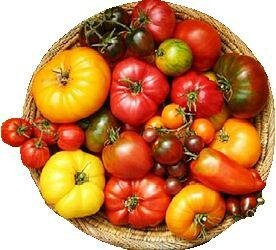
If you're not going to load your cart and hitch up Neddy to go off to the market at the other end of the country, then you don't need to grow tough, cardboardy, boring fruits and vegetables.
Grow what you like to eat and give away, or sell locally. Grow tender, sweet, tasty dudes that dribble down your chin, or snap with nuttiness, or ooze with tangy delight... and are good for you.
You can safely save the seeds of heirlooms because they are all open pollinated, so this will save you money.
You can also localize your heirloom seeds because of their well-known adaptability. That means each year you select the best plants to save seeds from, and over time the slight variations will produce a slight strain difference that has adapted perfectly to your particular climate and conditions.
Heirloom seeds give you huge choices, different ripening times and lots of fun experimenting with all their quirky shapes, colours and characteristics.
Oh boy, the taste that dreams are made of. Start dreamin' at Heirloom Seeds
Hybrid Seeds
Some 10,000 years ago, agriculture began when hunter gatherer type people purposely poked a few seeds in a patch of ground, tended them, and then ate the harvest.
Over the years they tinkered with the genetic makeup of various plants, and watched as nature inadvertently did similar cross pollination by wind, birds, beasts and insects.
They noticed that sometimes a bigger and sweeter fruit would appear and soon learned to select the seeds of these better varieties to plant again.

In the 19th century, a European monk called Gregor Mendel, unravelled the genetic code of plants, starting with peas. Mendel's code pertains to many life forms and answers question as to why two blue-eyed humans can produce a brown-eyed baby.
Hybridization of plants has greatly expanded our choices. Hybridists and common-or-garden yokels are constantly producing new hybrids, seemingly better than before. These are done under closed pollination conditions to keep away birds, bees and wind.
For example, we can take a strawberry plant which produces luscious strawberries, but sadly averages only two fruits per plant. But if we take the seeds of those strawberries and cross pollinate them with the seeds of a strawberry plant that has abundant fruit, but with average lusciousness. Then we have a new hybrid strawberry plant... with abundant, luscious fruit.
Ah would it be so easy! It can take up to many thousands and more attempts to get the characteristics we desire. Over generations of experiments, finally it can pay off, and a new hybrid is produced. Or maybe not, because this grand new hybrid somehow is too disease prone to stand up to general commercial conditions... so back to the greenhouse to go down another gene line.
Features such as fast growth, high yields, delicious taste, pest and disease resistant, frost proof and so on, have changed original wild plants into unrecognisable descendants that we rely on today to feed us.
Corn is a good example. From little finger sized wild corn found in North and South America, we now have hundreds of varieties that feed livestock and humans — some larger than a policeman's foot!
And desirable characteristics have been bred into other plants that provide us with superior building materials, clothing fibre, beauty, and flood, desert or erosion control.

Other benefits of Seed Hybridization:
- Higher yields
- Improved fruit setting
- Reduced pest and disease problems due to stronger vigour
- Extended growing season
- Earlier maturity
- Withstands adversities, such as weather stresses
- Known outcomes in terms of uniformity
But in truth, most of the seed-saving gardeners I know, don't concern themselves about the odd maverick vegetable and just love saving seeds.
The odds are more in our favour for pure reproduction. There's always the possibility of a super duper hybrid appearing!
Disadvantage of Hybrids:
Very sadly the progress made with our edible plants, coupled with our food and buying habits has resulted in many cases in us, the public, having less choice!
Hybrids now fill up supermarket shelves. They are routinely bred with tough skins to stop damage; same shape and size for easy packing; less sweetness to repel insect, bird and animal damage: capable of being picked green and ripened in storage with gas... so we end up with less taste, less softness, less nutrition, and less choice of varieties and sizes.
With the newer hybrids, seeds saved will generally not breed true and revert to the parents' traits. You may be lucky and depending on the variety, you could save the seeds for another year or so and they will still be like your original seeds. But eventually you will have to buy new seeds if you want the same results — or with some plants you can propagate them from cuttings or from division.
What are New Hybrid or F1 & F2 hybrids?
F1 (First filial generation) and F2 hybrid seeds produce vigorous, uniform plants. These hybrids are produced after extensive inbreeding to arrive at plants with totally predictable characteristics.
Pure genetic lines have been crossed and re-crossed with each other over many generations, and at obviously great expense.
The pure gene lines of these new hybrids need to be constantly maintained, so that the same F1 & F2 hybrid seeds are produced each year. This is done in controlled conditions by hand.
You can see why F1 & F2 seeds cost an arm and a leg.
Genetically modified seeds (GMO — Genetically modified Organisms)

Genetic modification means introducing the DNA of one species, say animals into another species, in this case, plants. This is done in laboratories, and involves combining genes from one species into a completely different one (think fish and corn) — something that is impossible for nature to do. The risks are enormous and the outcomes for the future are unknown and feared dangerous.
Home garden vegetables are so far not genetically modified. Many major crops like corn, soybeans and wheat are now grown with GMO seed, bred to resist certain chemicals such as herbicides.
Most GMO crops have been designed to produce sterile seeds by inserting what they call a gene terminator. This means farmers have to re-purchase new seeds each year from the corporations that own the patent rights to these seeds.
History will show just who is playing fast and loose with the truth on genetic modification of our food. We need to know soon whether GMO is good progress... or a very fast disaster in the making, for all life on earth.
For more information on Saving, Storing and Growing Seeds and Seedlings, follow these links below:
Vegetable Seedlings: How and why to grow your own vegetable seeds.
Seed Saving & Storing: It's fun and cheaper to save your own seeds.
Starting Seedlings Indoors: How to give your vegetable seeds a head start.
Vegetable Sowing Guides: Seed sowing guides for different climate regions.
Germination Guide: Seed sprouting times, stratification, scarification & chitting.
Hearty Heirlooms!
Your tastebuds, your joy, your very heartbeat will dance to the rhythm of the same song when you savour these luscious beauties. I've sourced the best seeds for you, at by far the best price. Check out Best Heirloom Seed Products
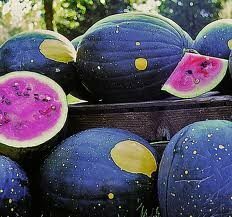
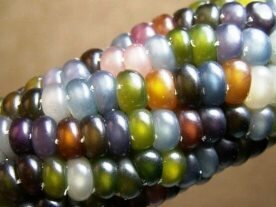
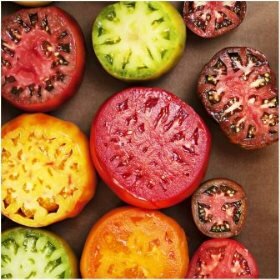
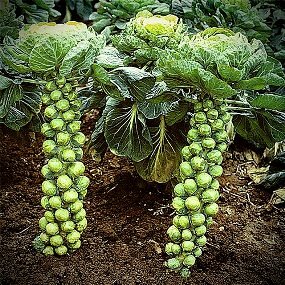
You can grow these too! Click now Best Heirloom Seed Products
Garden Gift Hub is one of the most thoughtful and interesting places on the web to find original and useful gardening and nature inspired products.





